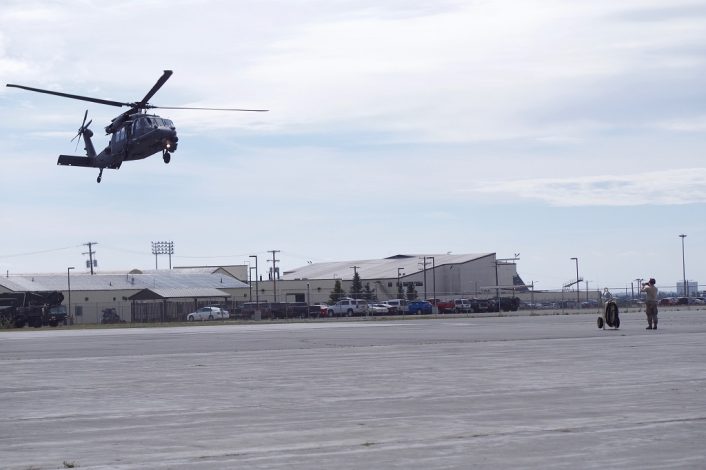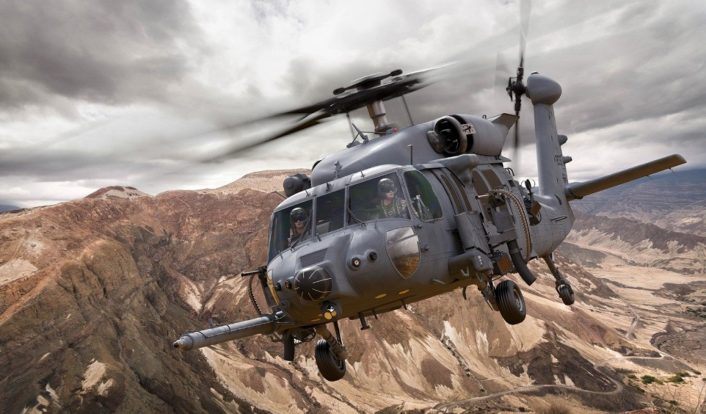The OLR program will replace the aircraft lost since 9/11 while waiting for the delivery of the new HH-60W.
The 210th Rescue Squadron took delivery of the first Operational Loss Replacement HH-60G Pave Hawk on Aug. 5, 2019, following a ferry flight from Nellis Air Force Base (Nevada) to Joint Base Elmendorf-Richardson (Alaska).
The OLR program is meant to replace the aircraft lost during combat operations since 9/11 (including one of the 210th RQS lost in Iraq in 2018), restoring the HH-60G fleet to its authorized size while also addressing issues with maintenance and availability of mission-capable aircraft. The Air Force acquired 21 low-hour UH-60Ls from the Army and is converting them into Pave Hawks by using a single technical package that integrates all the modifications implemented on the HH-60G fleet throughout its more than 30-year career.
According to a U.S. Air Force statement from 2016, when the first fully built helicopter was introduced for testing, “The service ensured the baseline helicopters they received from the Army were well-maintained, structurally sound aircraft with no systemic maintenance problems. Units scheduled to receive the re-missionized helicopters will see a marked improvement in sustainability from the aircraft they’re currently flying, as numerous aging and obsolescent systems were modernized to match today’s state-of-the-art capabilities. These include color weather radar, a digital symbol generator, improved tactical air navigation, new radar warning receivers, an automatic direction finder, and a digital intercommunication system.”

Alaska Air National Guard Maj. Paul Rauenhorst, a 210th RQS instructor pilot who ferried the new helicopter to Elmendorf, said that the OLR HH-60Gs are substantially younger than the current HH-60G: “These airframes are from 2001 to 2004 models, where ours sitting on the ramp are 1992 models.” The pilot also said that the helicopter will need some more modifications before being ready for real-world rescue missions in Alaska, like specially manufactured skis to allow safe landings on deep snow.
The 176th Wing is expecting improved flight performance from the OLR HH-60Gs due to the newer airframes and the removal of hundreds of pounds of redundant wiring, while also requiring less maintenance and providing a significantly higher availability rate for the fleet.
The availability rate of the Pave Hawk fleet declined in the last years due to age of the airframes and the high operations tempo of the fleet because of the continuous deployments for combat operations in Africa and the Middle East. According to a report from the Government Accountability Office “About 68 percent of the 96-helicopter fleet were mission-capable as of fiscal year 2017, below the Air Force desired mission-capable rate of 75 percent.” The same report noted that the average flight hours of the available helicopters is 7100 hours, while the expected flying life was 6000 hours, and the average depot-level maintenance increased from 233 days in fiscal year 2007 to 322 days in fiscal year 2017.

The OLR HH-60Gs will act as a stopgap measure until the Air Force starts fielding the new HH-60W, which flew for the first time earlier this year. The Air Force is planning to buy 113 helicopters to replace the entire Pave Hawk fleet beginning from 2020. The HH-60W Combat Rescue Helicopter is based on the UH-60M in service with the Army and features a nose-mounted radar, a EO/IR (Electro-Optical and InfraRed) sensor turret, a new digital RWR (Radar Warning Receiver), Link 16, crashworthy seats for crew and passengers, a new long-range fuel system and external weapon mounts, inherited for the HH-60G, for 7.62mm miniguns or .50 caliber machine guns.









